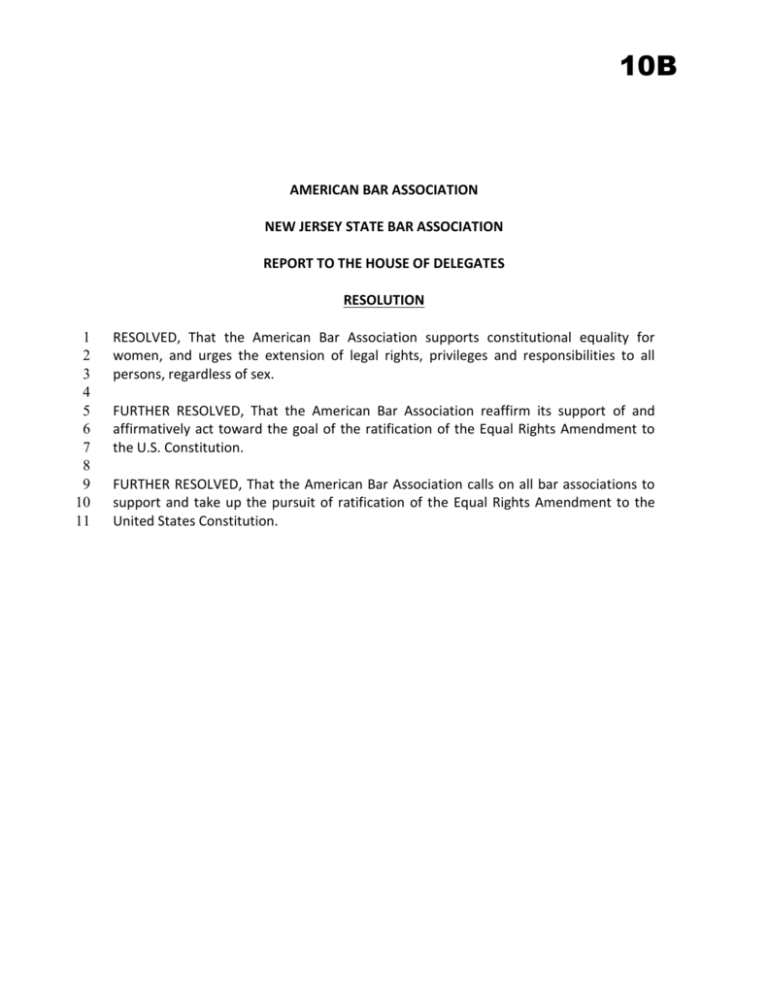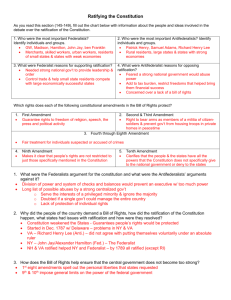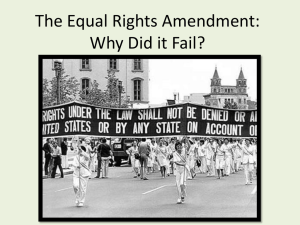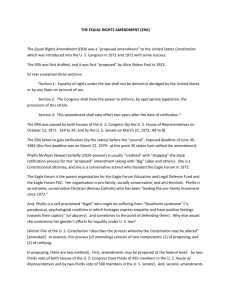10B - American Bar Association
advertisement

10B AMERICAN BAR ASSOCIATION NEW JERSEY STATE BAR ASSOCIATION REPORT TO THE HOUSE OF DELEGATES RESOLUTION 1 2 3 4 5 6 7 8 9 10 11 RESOLVED, That the American Bar Association supports constitutional equality for women, and urges the extension of legal rights, privileges and responsibilities to all persons, regardless of sex. FURTHER RESOLVED, That the American Bar Association reaffirm its support of and affirmatively act toward the goal of the ratification of the Equal Rights Amendment to the U.S. Constitution. FURTHER RESOLVED, That the American Bar Association calls on all bar associations to support and take up the pursuit of ratification of the Equal Rights Amendment to the United States Constitution. 10B REPORT The proposed Equal Rights Amendment states, Section 1. Equality of rights under the law shall not be denied or abridged by the United States or by any State on account of sex. Section 2. The Congress shall have the power to enforce, by appropriate legislation, the provisions of this article. Section 3. This amendment shall take effect two years after the date of ratification. Article V of the Constitution prescribes how an amendment can become a part of the U.S. Constitution. While there are two ways, only one has ever been used. All 27 successful amendments have been ratified after two-thirds of the House and Senate approved of the proposal and send it to the states for a vote. Then, three-fourths of the states (38 out of 50) were required to affirm the proposed amendment.1 ERA Background The ERA was originally presented in 1923 by Alice Paul, a leader in the women’s suffrage movement who held three law degrees. The current text is modeled after the 19 th Amendment, which Paul submitted it in 1943. While many aspects of the law have evolved to offer rights and protections to many in our society, basic legal protection against sex discrimination has not yet been realized and affirmed in the Constitution, even given the considerations of the 14 th Amendment. The ERA would make clear that discrimination based on sex is not allowed in the courts. Its adoption would further send a strong message to lawmakers that the highest law of the land does not tolerate disparate treatment of men and women. Adoption of this resolution would mobilize the nation’s largest lawyers organization, and hopefully activate the local, county and state bar associations around the country, to pressure public officials to make this necessary change that champions the defense of liberty and the pursuit of justice that informs the democratic question for a “more perfect union.” Through a chorus of voices in the legal profession the mission of advancing equality under the law can be fulfilled. The ERA has a long, storied history in United States political discourse. A nearly successful effort to enact the amendment occurred in the 1970’s when the amendment reached a zenith of having the necessary congressional approval in both houses and the In addition, a Constitutional Convention called by two-thirds of the legislatures of the several states can propose as many amendments as it deems necessary; those amendments must be approved by three-fourths of the states to be adopted, U.S. Const. Art. V. 1 1 10B affirmation of 35 out of 38 states. It ultimately failed to receive any further support. Later, five states de-affirmed their prior approvals between 1973-79. The current version of the ERA gained passage by the required two-thirds majority on March 22, 1972. President Richard Nixon endorsed the ERA's approval upon its passage by the 92nd Congress.2 The congressional approvals, including an extension resolution, contained an expiration clause, requiring that the ERA ultimately be adopted on or before June 30, 1982.3 As of that original deadline, the ERA had been ratified by the following states: Hawaii (March 22, 1972) Massachusetts (June 21, 1972) New Hampshire (March 23, 1972) Kentucky (June 26, 1972) Delaware (March 23, 1972) Pennsylvania (Sept. 27, 1972) Iowa (March 24, 1972) California (Nov. 13, 1972) Idaho (March 24, 1972) Wyoming (Jan. 26, 1973) Kansas (March 28, 1972) South Dakota (Feb. 5, 1973) Nebraska (March 29, 1972) Oregon (Feb. 8, 1973) Texas (March 30, 1972) Minnesota (Feb. 8, 1973) Tennessee (April 4, 1972) New Mexico (Feb. 28, 1973) Alaska (April 5, 1972) Vermont (March 1, 1973) Rhode Island (April 14, 1972) Connecticut (March 15, 1973) New Jersey (April 17, 1972) Washington (March 22, 1973) Colorado (April 21, 1972) Maine (Jan. 18, 1974) West Virginia (April 22, 1972) Montana (Jan. 25, 1974) Wisconsin (April 26, 1972) Ohio (Feb. 7, 1974) New York (May 18, 1972) North Dakota (March 19, 1975) Michigan (May 22, 1972) Indiana (Jan. 24, 1977) Maryland (May 26, 1972) This supplemented President John F. Kennedy’s endorsement of the provision in an October 21, 1960, letter to the chairman of the National Woman's Party 3 The original 1979 deadline was extended under the 95th Congress by House Joint Resolution No. 638 (H. J. Res. 638, 95th Cong., 1st Sess. (1977)), introduced by NY Representative Elizabeth Holtzman. Beginning in 1917, Congress has usually (but not always) imposed deadlines on proposed amendments. While the Constitution does not expressly provide for a deadline on the state legislatures' or state ratifying conventions' consideration of proposed amendments. In Dillon v. Gloss, 256 U.S. 368 (1921), the Supreme Court affirmed that Congress can provide a deadline for ratification. But Cf. Coleman v. Miller, 307 U.S. 433 (1935), in which the Court modified Dillon considerably, holding that the question of timeliness of ratification is a political and non-justiciable one, leaving the issue to Congress's discretion. It would appear that the length of time elapsing between proposal and ratification is irrelevant to the validity of the amendment. For example, the 27th Amendment was proposed in 1789 and ratified more than 200 years later in 1992. On May 20, 1992, both houses of Congress adopted concurrent resolutions accepting the 27th Amendment's unorthodox ratification process as having been successful and valid. 2 2 10B Affirmations were later rescinded by five of those states as follows: Nebraska (March 15, 1973 – Legislative Resolution No. 9) Tennessee (April 23, 1974 – House Joint Resolution No. 371 and Senate Joint Resolution No. 29) Idaho (Feb. 8, 1977 – Senate Joint Resolution No. 133 and House Concurrent Resolution No. 10) Kentucky (March 17, 1978 – House (Joint) Resolution No. 2 and House (Joint) Resolution No. 20) South Dakota (March 1, 1979 – Senate Joint Resolution No. 1 and Senate Joint Resolution No. 2) South Dakota's own ratification of the ERA would only be valid up until March 22, 1979, and any ratification activities transpiring after that date anywhere else would be considered by South Dakota to be null and void. (It is important to note that the U.S. Constitution is silent regarding a state's authority to rescind its ratification of a proposed, but not yet adopted, constitutional amendment.) On Dec. 23, 1981, in Idaho v. Freeman, 529 F. Supp. 1107 (1981), the United States District Court for the District of Idaho ruled that the rescissions—all of which occurred before the original 1979 ratification deadline—were valid and that the ERA's deadline extension was unconstitutional. The National Organization for Women appealed the ruling. However, the acting solicitor general reported to the Court that the administrator of general services concluded the ERA had not received the required number of ratifications, so "the Amendment has failed of adoption no matter what the resolution of the legal issues presented here." He urged the Court to dismiss the complaint. On Oct. 4, 1982, in NOW v. Idaho, 459 U.S. 809 (1982), the U.S. Supreme Court vacated the ruling in Idaho v. Freeman and declared the entire matter moot on the grounds that the ERA was dead for the reason given by the administrator of general services. There remains considerable academic and political disagreement on whether the ERA can be revised and ratified by achieving ratifications of an additional three states’ under the 35- of 38-state tally noted above; to wit, a “three-state strategy.” 4 That strategy is discussed in a 1997 article called “The Equal Rights Amendment: Why the Era Remains Legally Viable and Properly Before the States” in the William & Mary Journal of Women and the Law. In 2013, a report of the Library of Congress's Congressional Research Service (Thomas H. Neale, The Proposed Equal Rights Amendment: Contemporary Ratification Issues, Congressional Res. Serv., (May 9, 2013)) examined the legislative history and provided an analysis of the factors affecting its viability. 4 Allison L. Meld, Sheryl L. Herndon and Danielle M. Stager, The Equal Rights Amendment: Why the Era Remains Legally Viable and Properly Before the States, 3 Wm. & Mary J. Women & Law. 113 (1997). 3 10B Proponents of the three-state strategy have promoted ratification resolutions in the legislatures of most of the 15 states that never ratified the ERA approved by Congress in 1972, but no approval has been forthcoming. Going Forward to Success - ERA 2020 While the ERA has been introduced in every session of Congress since 1982, it has not achieved a critical mass to propel it to success. Its time has come and, as thought leaders on legal issues, lawyers can be the agents of that change. This association has long studied and supported the fundamental underpinnings of the ERA. It supported ratification of the proposed 27th Amendment to the Constitution initially in Feb. 1972 and again in Aug. 1974. This resolution would directly advance those previously stated goals. Additionally, it speaks to the ABA’s general policies, such as Goal III for the Association, which states: “Promote full and equal participation in the association, our profession, and the justice system by all persons.” This is the opportunity to finish the job of delivering on the basic and fundamental right of equality based on sex under the law. Respectfully submitted, Miles S. Winder III, President New Jersey State Bar Association February 2016 4 10B GENERAL INFORMATION FORM Submitting Entity: New Jersey State Bar Association Submitted By: Miles S. Winder, III, President 1. Summary of Resolution(s). This resolution seeks the affirmation of the American Bar Association’s support of the ratification of the Equal Rights Amendment to the U.S. Constitution. Further, it asks other legal entities to consider same, and, if approved, act to that effect. 2. Approval by Submitting Entity. The New Jersey State Bar Association authorized this action at its Oct. 16, 2015 Board of Trustees meeting. 3. Has this or a similar resolution been submitted to the House or Board previously? Yes, many years ago, see answer #4. 4. What existing Association policies are relevant to this Resolution and how would they be affected by its adoption? The ABA supported ratification of the proposed 27th Amendment to the Constitution initially in Feb. 1972 and again in Aug. 1974. This resolution would directly advance those previously stated goals. Additionally, support of this effort speaks to Goal III of the association, to provide equal opportunities for women and minorities. 5. If this is a late report, what urgency exists which requires action at this meeting of the House? N/A 6. Status of Legislation. (If applicable) The Equal Rights Amendment was originally presented in 1923. It was nearly approved in the 1970s, garnering support in 35 (of the necessary 38) states. Some states de-affirmed their prior approval. It has since been reintroduced in every session of Congress, most recently in the 117 th Congress, in which two types of ERA legislation has been introduced. One seeks the traditional ratification process and a second proposes the “three-state strategy.” Both are pending. 7. Brief explanation regarding plans for implementation of the policy, if adopted by the House of Delegates. The NJSBA will work with the ABA to use all available, existing resources, including but not limited to social media, communications, and government affairs. 8. Cost to the Association. (Both direct and indirect costs) Direct costs are not anticipated, but additional time and energy of the existing government affairs program may be sought, if adopted. 5 10B 9. Disclosure of Interest. (If applicable) N/A 10. Referrals. Referred to the Commission on Women, NCBP, NABE and the Diversity Center. 11. Contact Name and Address Information. (Prior to the meeting. Please include name, address, telephone number and e-mail address) Kate Coscarelli, senior managing director of communications and media relations, New Jersey State Bar Association, One Constitution Square, New Brunswick NJ 08901, 732-937-7548 or kcoscarelli@njsba.com 12. Contact Name and Address Information. (Who will present the report to the House? Please include name, address, telephone number, cell phone number and e-mail address.) Thomas H. Prol, President-Elect NJSBA, 60 Blue Heron Road, Sparta NJ 07871, 973-862-9817 or tprol@lcrlaw.com; Wayne J. Positan, New Jersey Delegate, 103 Eisenhower Parkway, Roseland NJ 07068, or wpositan@lumlaw.com. 6 10B EXECUTIVE SUMMARY 1. Summary of the Resolution This resolution seeks the affirmation of the American Bar Association’s support of the ratification of the Equal Rights Amendment to the U.S. Constitution. Further, it asks other legal entities to consider same, and, if approved, act to that effect. 2. Summary of the Issue that the Resolution Addresses Ratification of the ERA was originally presented by Alice Paul in 1923. It was nearly successfully enacted in the 1970s, but fell short. While many aspects of the law have evolved to offer rights and protections to many in our society, basic legal protection against sex discrimination has not yet been realized and affirmed in the Constitution, even given the considerations of the 14th Amendment. The ERA would make clear the legal status of sex discrimination in the courts and would send a clear message to lawmakers that the highest law of the land does not tolerate men and women being treated as separate classes. 3. Please Explain How the Proposed Policy Position will address the issue Adoption of this resolution would mobilize the nation’s largest lawyers organization, and hopefully activate the local, county and state bar associations around the country, to pressure public officials to make this necessary change that champions the defense of liberty and the pursuit of justice that informs the democratic question for a “more perfect union.” Through a chorus of voices in the legal profession the mission of advancing equality under the law can be fulfilled. 4. Summary of Minority Views Some believe it is not necessary given other laws on discrimination and court decisions. 7









